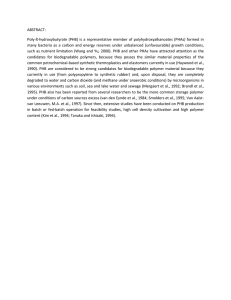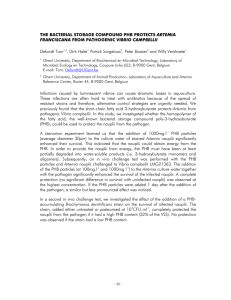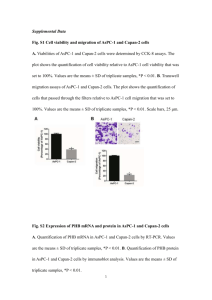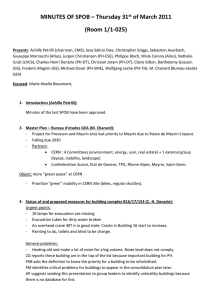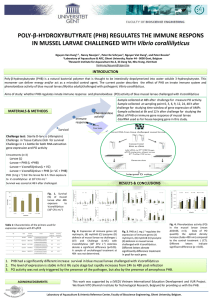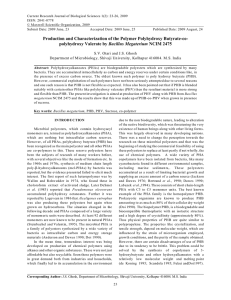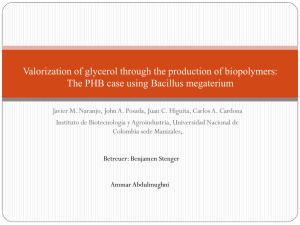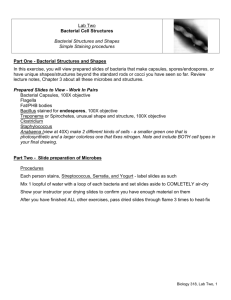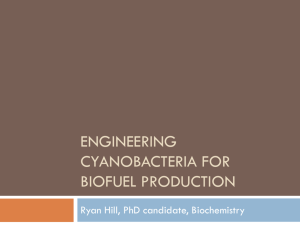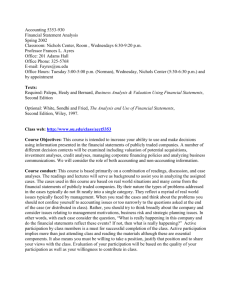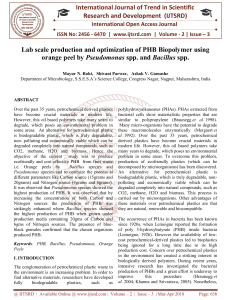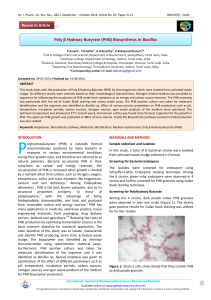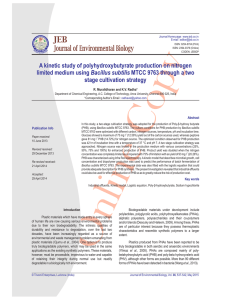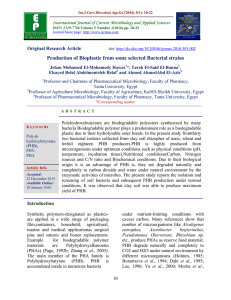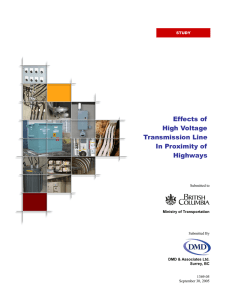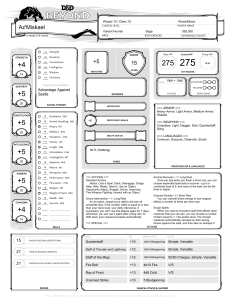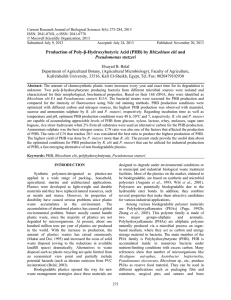β-HYDROXYBUTYRATE THE BACTERIAL STORAGE COMPOUND POLY- (PHB) INCREASES GROWTH PERFORMANCE AND INTESTINAL
advertisement
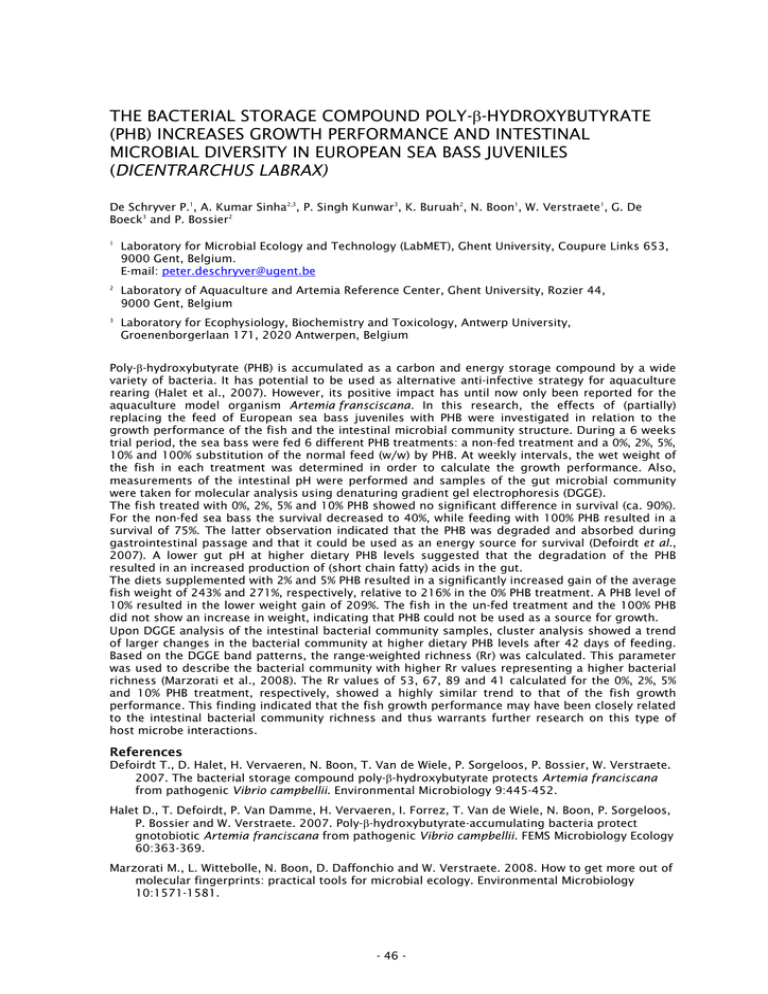
THE BACTERIAL STORAGE COMPOUND POLY-β-HYDROXYBUTYRATE (PHB) INCREASES GROWTH PERFORMANCE AND INTESTINAL MICROBIAL DIVERSITY IN EUROPEAN SEA BASS JUVENILES (DICENTRARCHUS LABRAX) De Schryver P.1, A. Kumar Sinha2,3, P. Singh Kunwar3, K. Buruah2, N. Boon1, W. Verstraete1, G. De Boeck3 and P. Bossier2 1 Laboratory for Microbial Ecology and Technology (LabMET), Ghent University, Coupure Links 653, 9000 Gent, Belgium. E-mail: peter.deschryver@ugent.be 2 Laboratory of Aquaculture and Artemia Reference Center, Ghent University, Rozier 44, 9000 Gent, Belgium 3 Laboratory for Ecophysiology, Biochemistry and Toxicology, Antwerp University, Groenenborgerlaan 171, 2020 Antwerpen, Belgium Poly-β-hydroxybutyrate (PHB) is accumulated as a carbon and energy storage compound by a wide variety of bacteria. It has potential to be used as alternative anti-infective strategy for aquaculture rearing (Halet et al., 2007). However, its positive impact has until now only been reported for the aquaculture model organism Artemia fransciscana. In this research, the effects of (partially) replacing the feed of European sea bass juveniles with PHB were investigated in relation to the growth performance of the fish and the intestinal microbial community structure. During a 6 weeks trial period, the sea bass were fed 6 different PHB treatments: a non-fed treatment and a 0%, 2%, 5%, 10% and 100% substitution of the normal feed (w/w) by PHB. At weekly intervals, the wet weight of the fish in each treatment was determined in order to calculate the growth performance. Also, measurements of the intestinal pH were performed and samples of the gut microbial community were taken for molecular analysis using denaturing gradient gel electrophoresis (DGGE). The fish treated with 0%, 2%, 5% and 10% PHB showed no significant difference in survival (ca. 90%). For the non-fed sea bass the survival decreased to 40%, while feeding with 100% PHB resulted in a survival of 75%. The latter observation indicated that the PHB was degraded and absorbed during gastrointestinal passage and that it could be used as an energy source for survival (Defoirdt et al., 2007). A lower gut pH at higher dietary PHB levels suggested that the degradation of the PHB resulted in an increased production of (short chain fatty) acids in the gut. The diets supplemented with 2% and 5% PHB resulted in a significantly increased gain of the average fish weight of 243% and 271%, respectively, relative to 216% in the 0% PHB treatment. A PHB level of 10% resulted in the lower weight gain of 209%. The fish in the un-fed treatment and the 100% PHB did not show an increase in weight, indicating that PHB could not be used as a source for growth. Upon DGGE analysis of the intestinal bacterial community samples, cluster analysis showed a trend of larger changes in the bacterial community at higher dietary PHB levels after 42 days of feeding. Based on the DGGE band patterns, the range-weighted richness (Rr) was calculated. This parameter was used to describe the bacterial community with higher Rr values representing a higher bacterial richness (Marzorati et al., 2008). The Rr values of 53, 67, 89 and 41 calculated for the 0%, 2%, 5% and 10% PHB treatment, respectively, showed a highly similar trend to that of the fish growth performance. This finding indicated that the fish growth performance may have been closely related to the intestinal bacterial community richness and thus warrants further research on this type of host microbe interactions. References Defoirdt T., D. Halet, H. Vervaeren, N. Boon, T. Van de Wiele, P. Sorgeloos, P. Bossier, W. Verstraete. 2007. The bacterial storage compound poly-β-hydroxybutyrate protects Artemia franciscana from pathogenic Vibrio campbellii. Environmental Microbiology 9:445-452. Halet D., T. Defoirdt, P. Van Damme, H. Vervaeren, I. Forrez, T. Van de Wiele, N. Boon, P. Sorgeloos, P. Bossier and W. Verstraete. 2007. Poly-β-hydroxybutyrate-accumulating bacteria protect gnotobiotic Artemia franciscana from pathogenic Vibrio campbellii. FEMS Microbiology Ecology 60:363-369. Marzorati M., L. Wittebolle, N. Boon, D. Daffonchio and W. Verstraete. 2008. How to get more out of molecular fingerprints: practical tools for microbial ecology. Environmental Microbiology 10:1571-1581. - 46 -
